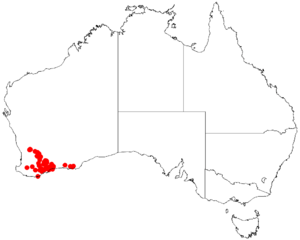Acacia mimica facts for kids
Quick facts for kids Acacia mimica |
|
|---|---|
| Scientific classification | |
| Genus: |
Acacia
|
| Species: |
mimica
|
 |
|
| Occurrence data from AVH | |
The Acacia mimica is a type of shrub. It belongs to the Acacia family. This plant is special because it only grows in one place: southwestern Australia. When a plant or animal only lives in one specific area, we call it endemic.
What Does Acacia Mimica Look Like?
This plant is a thick shrub. It usually grows between 0.3 and 2.5 meters (about 1 to 8 feet) tall. It can stand straight up or spread out a bit. Its small branches can be smooth or a little bit hairy.
Like most Acacia plants, it doesn't have regular leaves. Instead, it has something called phyllodes. These are like flattened leaf stems that do the job of leaves. The phyllodes of Acacia mimica are stiff and feel a bit like leather. They are grey-green and smooth.
These phyllodes can be straight or curved. They are long and narrow, measuring about 1.8 to 10.5 centimeters (0.7 to 4.1 inches) long. They are also about 2 to 7 millimeters (0.08 to 0.28 inches) wide. You can see many raised lines, or "nerves," on them. The nerves along the edges are often bright yellow.
The Acacia mimica produces pretty yellow flowers. These flowers usually appear between July and October.
Different Types of Acacia Mimica
Scientists have found two slightly different kinds, or "varieties," of Acacia mimica:
- Acacia mimica var. angusta
- Acacia mimica var. mimica
The yellow nerves on this plant make it look a bit like another Acacia species called Acacai patagiata.
Where Does Acacia Mimica Grow?
This shrub is found in several regions of Western Australia. These areas include the Wheatbelt, Great Southern, and Goldfields-Esperance regions.
You can often find Acacia mimica growing on sandy plains, rocky hills, and small rises. It likes to grow in soils made of clay, loam, or sand. Sometimes, these soils also have gravel in them.
The plant's natural home stretches from Goomalling in the northwest. It goes down to Borden in the southeast. It also reaches as far east as Ravensthorpe. You might even find some groups of these plants near Scaddan and Mount Burdett, which are even further east.

